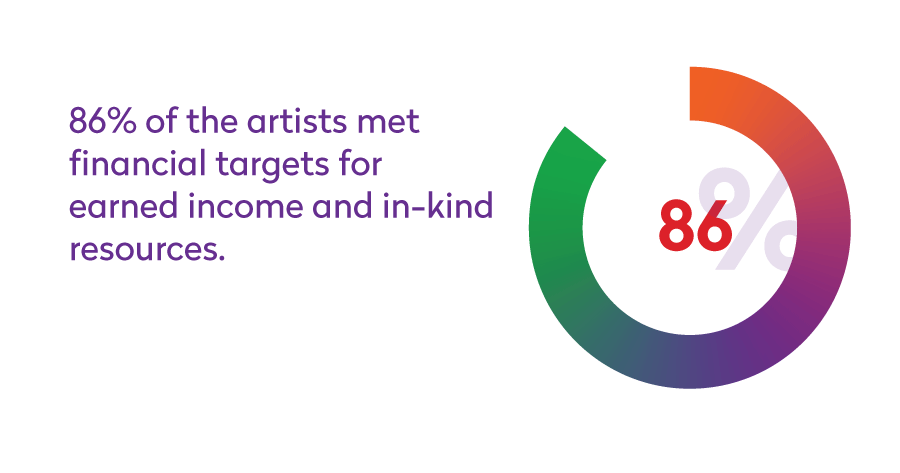Findings
Analysis of quantitative and qualitative data strongly suggests that the ART Program succeeded and fostered artistic growth and built administrative competence for artists in the capacity group to help them move to the next level of sustainability.
To review, the hypothesis of this research posits that by providing dance makers with comprehensive, bundled, capacity-building services over two and one-half years, artists will 1) create viable artistic and business plans and 2) 75% of the artists will increase their earned income, contributions, and in-kind resources. In addition, because of the limited resources available for dance artists, the artists in the capacity-building cohort will do better than the similarly qualified artists in the comparison cohort who are pursuing the same goals, but without access to a full complement of administrative resources.
ART ACHIEVEMENTS
Capacity Group
The focus in the first year was on the development of the artists’ artistic vision and capacity-building plans and establishing methods of communication between the artists, mentors, and administrators. In years two and three the focus was on implementing and executing the artists’ artistic and capacity plans. Results include:
- 85% of the capacity cohort artists stated that they were satisfied or very satisfied with their mentor and administrator and the goals that were achieved.
- 86% of the artists met financial targets for earned income and in-kind resources and 71% met the target for contributions.
- Average income in the capacity cohort grew 39% between 2017-2019.
- The number of performances increased by 10% over this period.
- More time was available to focus on artistic vision and performance preparation due to support from administrators and mentors.
- New artistic strategies were developed with mentors who frequently acted as a sounding board, identified opportunities for performances, grants and residencies, and helped to “polish the work.”
- Attitudinally, artists felt that they were recognized for their vision and singular approach to their art.
- Artists had a better understanding of business practices and instituted more transparency in their company and personal finances.
- Artists became better at time management and learned how to effectively delegate tasks to administrators and mentors.
- Several artists embarked on new fundraising campaigns with support of ART administrators using crowd funding and other strategies that were very productive.
- Marketing materials, mailing lists, and artist web sites were developed or improved.
The required reporting, survey, and interview requirements of the comparison group artists were vitally important to the research design of the ART program. Even though the comparison group received few direct benefits, there was no attrition because of their sustained interest and commitment.
- All eight artists in the comparison cohort stayed engaged and participated from 2017-2019 even though it required submitting reports and attending interviews and assessment meetings.
- Dance makers in this group were aware and supportive of the potential value of the ART program to add knowledge to the field.
- Receipt of an honorarium for participation.
- Each artist received a baseline and exit assessment from the same external team that provided analysis and recommendations about how to create a stronger administrative foundation and business structure.
ART DESIGN CHALLENGES
As a new program, ART had skeletal policies and procedures in place at the beginning of 2017, based in part on other Pentacle programs. ART program directors had to refine and adjust the program guidelines to facilitate and enhance the delivery of administrative services. As noted earlier, developing productive and respectful relationships among artists, mentors, and administrators took time, and in some cases differences in an artist’s vision or working style did not align with a mentor or the work schedules or aptitudes of administrators. The following comments are from capacity group artists and mentors:
- Some artists and mentors stated that it took too much time to ramp-up ART, and roles and responsibilities of artists, mentors, and administrators were unclear when the program launched.
- Effective communication was sometimes a challenge among the program participants, particularly within the artist, mentor, and administrator teams early in the process of establishing personal relationships and working routines.
- Sometimes the artist-mentor teams were not compatible, and even though ART program directors arranged new mentors, time was lost when new relationships had to be established and new directions charted. There could be a “courting period” before matches are made.
- Mentors suggested that in the future, they could help design the progress reports that could reflect shared benchmarks and the differences among independent, emerging, and mid-career artists.
- The idea of ART is strong, but it was not originally an artist-driven design. It was designed by administrators, and artists should have had input in the beginning.
- There were few opportunities for peer-to-peer learning and sharing of experience among the capacity-building cohort to build community. Some artists observed that this is a larger issue in the dance field.
- Likewise, mentors did not have periodic or interim group meetings to share their experience and strategies to support their artists.


